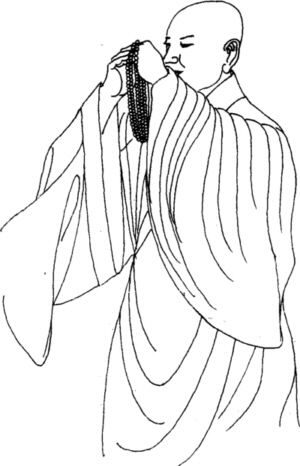Chapter 32 Section 3 Counting Beads
Counting beads is a free translation of Sanskrit Pasaka-mala, and it is also translated as rosary beads and Buddha beads.Transliteration "Bo Saimo".It is a tool used by Buddhists to count when they recite the Buddha's name or mantra.It is evolved from Yingluo and Huaman.From being worn on the body only for solemn purposes to pinching and counting, it can be realized in a single thought, and it depends on who turned the thought first.The archaeological and historical data of the ancient South Asian subcontinent prove that both Brahmans and Vishnus have the habit of wearing and mastering counting beads.Buddhism still learned from Brahmans.However, there is no record of the use of number beads in the Vinaya Department of the Tripitaka.There are clear records in Tantric classics. For example, it is often mentioned that some bodhisattvas next to the Buddha are holding counting beads, and there are even sayings about the various merits of counting beads.In Sinicized Buddhism, during the Sui and Tang Dynasties, with the prosperity of Pure Land Sect and Esoteric Buddhism, counting beads became popular. Since then, they have become an important accessory for the seven congregations of Sinicized Buddhism, and an important symbol of chanting and believing in Buddhism.However, in Theravada Buddhism, it is still not popular to wear and use counting beads.
There are a few things to say about counting beads.
The first is the number of beads in a string.Generally, there are nine types, as shown in the table below.Among them, one of the hundred and eight seeds is the basis, and the commonly used one is this kind.As for the connotation of various expressions, it is difficult to explain in one word, and ordinary readers do not need to delve into it, as long as they have a general understanding.

monk holding beads
Secondly, a large "golden bead" is often added to a string of counting beads as the "mother bead"; ten "silver beads" are added as "recorders". "Mother bead" means the existence of the Buddha of immeasurable life (that is, Amitabha Buddha), and the child means "ten paramitas".This is the number beads used by the Pure Land School to commemorate the number of Buddhas.Tantra recites mantras seven times or 21 times as a routine.In Tantric counting beads, four different or the same kind of slightly smaller beads are inserted after every seven or 21 beads, which are called "four sky beads" and are also used as memorizers.The number of beads sold in general temples is often slightly reduced according to the regulations of the Pure Land Sect.Usually the counting beads are black or brown, and a large yellow or red bead is added as a "golden bead" in the center, and a few (usually less than ten, more than three to fill the number) light yellow or white small beads are added as "silver beads". Never mind.
Again, talk about the material of the beads.It is said that chanting scriptures with different materials of beads will bring different merits.The quality is good, and the merits are multiplied.As for what kind of material counting beads will get how many times the merit, different scriptures have different opinions. Let's take the "Shuzhu Merit Sutra" as an example, and don't be attached.
Add a few words of explanation:
朵槵〔huanhuan〕zi is the free translation of the Sanskrit word Arista, transliterated as "阿里色嘉紫".Wood tree is a kind of "no danger" tree, which is feared by all ghosts.Its fruit Muzizi also has the power to bring down strong ghosts and gods.
Di Shiqingzi is the free translation of Sanskrit Indranilaksa, and the transliteration is "Indra Nilakacha".Also known as "Azure Pearl".It is said that it is a precious pearl born from a kind of precious tree where Di Shitian lived.
Vajra is the fruit of the legendary Vajra tree (also known as Tianmu tree).It is said to be like a peach pit, the size of a cherry, and purple.
Bodhi child refers to the fruit of the Bodhi tree.It is round, with a circle and many small dots on it, called "Xingyue Bodhi".In China, it is only produced in the Guangdong area, and it was introduced from the South Asian subcontinent. Therefore, the fruit of the annual herb "Chuan Gu" is often used in the mainland to replace it. It is round and white in color, also known as Bodhi Seed.There is another Tibetan fruit called Bodi-ci in Tibet, which is produced in the snow-capped mountains and can also be used as counting beads. The translated name is also called Bodhizi.

monk holding beads
